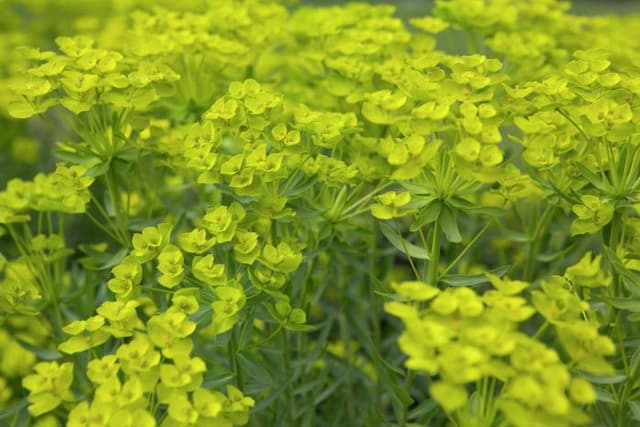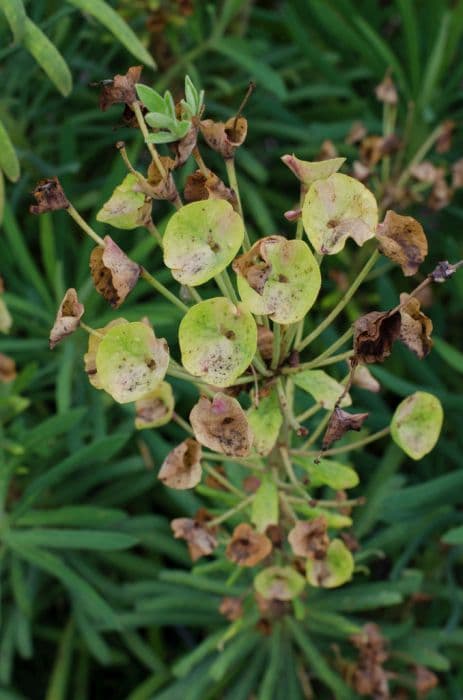Martin's Spurge Euphorbia × martini 'Baby Charm'

ABOUT
The 'Baby Charm' is an attractive perennial plant with a distinctive appearance. It features a compact, bushy habit with an array of closely packed stems. The foliage is narrow and lance-shaped, often displaying a blue-green hue, which provides a lovely contrast to other plants. Throughout the growing season, the foliage may also have a hint of purple along the edges, adding to its visual interest. On top of this attractive foliage, 'Baby Charm' produces vibrant blooms that stand out against the leaves. The flowers themselves are actually tiny structures surrounded by showy, colorful bracts—modified leaves—that are typically a bright green with a hint of red at the center, giving the impression of a flower. These bracts can last for a long time, extending the period of visual interest well beyond that of many other flowering plants. The overall growth habit of 'Baby Charm' tends to be mounded, which makes it an excellent choice for borders or as part of a mixed container. The plant's textural foliage along with its eye-catching bracts creates a striking appearance and adds year-round interest to gardens and landscapes without outgrowing its intended space.
About this plant
 Names
NamesFamily
Euphorbiaceae
Synonyms
Martin's Spurge, Baby Charm
Common names
Euphorbia × martini 'Baby Charm'.
 Toxicity
ToxicityTo humans
The Spurge 'Baby Charm' contains a toxic white sap that can cause skin irritation and inflammation upon contact. If the sap gets in the eyes, it can lead to severe eye irritation and temporary blindness. If ingested, the plant can cause nausea, vomiting, and diarrhea. The ingestion of large quantities can be particularly dangerous and medical attention should be sought immediately in such cases.
To pets
The Spurge 'Baby Charm' is toxic to pets as well. The milky sap of the plant can cause similar symptoms in pets as it does in humans, including skin and eye irritation. If ingested by animals, it can lead to vomiting, diarrhea, and possibly more severe gastrointestinal distress. Pet owners should prevent their animals from chewing on or ingesting this plant, and seek veterinary care if exposure occurs.
 Characteristics
CharacteristicsLife cycle
Perennials
Foliage type
Evergreen
Color of leaves
Green
Flower color
Yellow
Height
1-1.5 feet (30-45 cm)
Spread
1-1.5 feet (30-45 cm)
Plant type
Shrub
Hardiness zones
6-9
Native area
Mediterranean
Benefits
 General Benefits
General Benefits- Low maintenance: 'Baby Charm' requires minimal care once established, making it ideal for gardeners with limited time.
- Drought tolerance: As a hybrid of Euphorbia species, this plant is capable of withstanding periods of low water availability.
- Attractive foliage: The plant has a stunning foliage that adds aesthetic appeal to gardens and landscapes.
- Long blooming season: It produces flowers for an extended period, providing a prolonged display of color.
- Deer resistance: Typically resistant to deer, which can help to prevent damage in gardens where deer browsing is a problem.
- Pest resistance: 'Baby Charm' tends to have fewer problems with pests, reducing the need for chemical treatments.
- Adaptability: This plant can adapt to a variety of soil types, as long as they are well-drained.
- Compact size: Its small size makes 'Baby Charm' suitable for use in smaller gardens or as a border plant.
- Year-round interest: Offers visual interest throughout the seasons, especially when the foliage changes color in colder months.
 Medical Properties
Medical PropertiesThis plant is not used for medical purposes.
 Air-purifying Qualities
Air-purifying QualitiesThis plant is not specifically known for air purifying qualities.
 Other Uses
Other Uses- Creative arts and crafts: The unique structure of Martin's Spurge can be incorporated into floral arrangements, providing a splash of color and an interesting texture.
- Photography prop: Garden photographers may use Martin's Spurge as a subject or backdrop for close-up photos due to its uncommon form and vibrant colors.
- Educational model: Martin's Spurge can be used in botany classes to demonstrate plant hybridization, as it is a hybrid species.
- Color dye: Historically, some Euphorbia species have been used to produce dyes, and Martin's Spurge could potentially offer pigments for natural dyeing projects.
- Seasonal decoration: With its red and green colors, it can be used as a living decoration during the Christmas season.
- Garden sculpture: When dried, the stems and bracts of Martin's Spurge can be varnished and used in creating garden sculptures or ornaments.
- Fish tanks: While not typical, dried and treated parts of the plant could be used as decoration in fish tanks, provided all toxic sap is completely removed.
- Markers for garden beds: Dried Euphorbia stems can be used to create natural and aesthetically pleasing markers for different sections in a garden.
- Theme gardens: Martin's Spurge can be used in conceptual or theatrical gardens to set a mood or theme, such as 'Fantasy' or 'Alien' due to its peculiar appearance.
- Costume design: Elements of Martin's Spurge could inspire or be used in avant-garde fashion or costume designs, particularly for nature-themed attire.
Interesting Facts
 Feng Shui
Feng ShuiThe Euphorbia 'Baby Charm' is not used in Feng Shui practice.
 Zodiac Sign Compitability
Zodiac Sign CompitabilityThe Euphorbia 'Baby Charm' is not used in astrology practice.
 Plant Symbolism
Plant Symbolism- Persistence: The Euphorbia × martini 'Baby Charm', commonly known as Spurge, is known for its resilient nature and its ability to thrive in difficult conditions, symbolizing persistence and the ability to overcome challenges.
- Protection: Spurge plants are often used in traditional medicine and are believed to have protective qualities against evil spirits, symbolizing safety and security.
- Healing: With its medicinal properties, Spurge symbolizes healing and the alleviation of physical or emotional pain.
- Cleansing: The sap of Spurge is used as a purgative, representing cleansing and the removal of negative energy or toxins from one's life.
 Water
WaterMartin's Spurge, or Euphorbia × martini 'Baby Charm', typically requires thorough watering, but it is crucial to let the soil dry out between waterings to prevent root rot. Water the plant when the top one inch of soil feels dry to the touch. Generally, during active growth periods in the spring and summer, this may mean watering approximately once a week with about 8-16 ounces of water depending on pot size. In the fall and winter, reduce the frequency to every other week or less, monitoring the soil moisture level to guide you.
 Light
LightMartin's Spurge prefers a location where it receives full sun to partial shade. The ideal spot would allow for at least 6 hours of direct sunlight each day. However, it is also tolerant of some afternoon shade, particularly in hotter climates, to prevent scorching.
 Temperature
TemperatureMartin's Spurge thrives in temperatures between 50°F and 75°F. It can tolerate a range from just above freezing, approximately 34°F, to moderately high temperatures up to 80°F, but it should be protected from extreme cold and frost.
 Pruning
PruningPruning Martin's Spurge helps to maintain its shape and encourage bushier growth. Light pruning can be done any time of year to remove dead or damaged stems. The best time for more extensive pruning is in the late winter or early spring, before new growth begins.
 Cleaning
CleaningAs needed
 Soil
SoilSpurge 'Baby Charm' thrives in a well-draining soil mix that can be composed of 2 parts peat-free compost, 1 part grit or perlite, and 1 part sand to ensure good drainage and aeration. The ideal soil pH for this plant is slightly acidic to neutral, ranging from 6.0 to 7.0.
 Repotting
RepottingSpurge 'Baby Charm' should be repotted once every 1-2 years to prevent it from becoming root-bound and to replenish the nutrients in its soil. This timing also allows for checking the health of the roots and making sure they are disease-free.
 Humidity & Misting
Humidity & MistingSpurge 'Baby Charm' prefers moderate to low humidity levels and can tolerate the dry indoor air commonly found in homes without the need for additional humidity.
 Suitable locations
Suitable locationsIndoor
Place in bright, indirect light; well-draining soil.
Outdoor
Full sun to partial shade; well-drained soil.
Hardiness zone
6-9 USDA
 Life cycle
Life cycleEuphorbia × martini 'Baby Charm', commonly known as Martin's Spurge, begins its life cycle as a seed, germinating in warm, well-drained soil in spring. Seedlings establish a root system and a basal rosette of leaves, before sending up a central stem. In its vegetative stage, the plant develops a bushy structure with an abundance of lance-shaped leaves. Eventually, it enters the flowering stage, typically in late spring to early summer, producing characteristic bracts that range from green to pinkish in color, surrounding small actual flowers. After pollination, seeds develop and are dispersed around the parent plant, either by wind, wildlife, or human intervention. This perennial can also spread vegetatively through root division, thus extending its lifecycle over several years.
 Propogation
PropogationPropogation time
Spring-Early Summer
Euphorbia × martini 'Baby Charm', commonly known as Martin's Spurge, is typically propagated by taking cuttings. This method is done by selecting healthy stems and cutting them into sections about 4 to 6 inches (10 to 15 centimeters) long using a sharp and clean knife or pruning shears. The best time to take cuttings for propagation is in late spring or early summer when the plant has plenty of growth energy. It is important while handling Euphorbia to wear gloves, as the milky sap can be irritating to skin and must not come into contact with eyes. The cuttings should be allowed to dry for a day or so, to let the cut end callous over, before planting them in a well-draining soil mix. To encourage rooting, the cuttings can be dipped in rooting hormone powder before planting. Once potted, place them in a warm, bright spot out of direct sunlight, keeping the soil moist but not waterlogged, until roots have formed.









